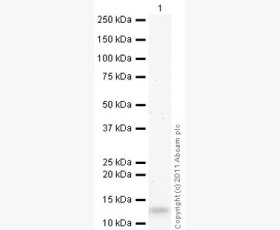Recombinant Human PDCD5/TFAR19
| Product name: | Recombinant Human PDCD5/TFAR19 |
| Source: | E. coli |
| Purity: | Greater than 95% as determined by reducing SDS-PAGE. |
| Buffer Formulation: | Lyophilized from a 0.2 μm filtered solution of 20mM PB,150mM NaCl,pH7.4. |
| Applications: | Applications:SDS-PAGE; WB; ELISA; IP. |
| Storage: | Avoid repeated freeze/thaw cycles. Store at 2-8 oC for one month. Aliquot and store at -80 oC for 12 months. |
| UOM: | 100ug/50ug/200ug/1mg/1g |
| Source | E. coli |
| Description | Recombinant Human Programmed Cell Death Protein 5 is produced by our E.coli expression system and the target gene encoding Met1-Tyr125 is expressed with a 6His tag at the N-terminus. |
| Names | Programmed Cell Death Protein 5, TF-1 Cell Apoptosis-Related Protein 19, Protein TFAR19, PDCD5, TFAR19 |
| Accession # | O14737 |
| Formulation | Lyophilized from a 0.2 μm filtered solution of 20mM PB,150mM NaCl,pH7.4. |
| Shipping |
The product is shipped at ambient temperature. |
| Reconstitution |
Always centrifuge tubes before opening. Do not mix by vortex or pipetting. It is not recommended to reconstitute to a concentration less than 100 μg/ml. Dissolve the lyophilized protein in ddH2O. Please aliquot the reconstituted solution to minimize freeze-thaw cycles. |
| Storage |
Lyophilized protein should be stored at < -20°C, though stable at room temperature for 3 weeks. Reconstituted protein solution can be stored at 4-7°C for 2-7 days. Aliquots of reconstituted samples are stable at < -20°C for 3 months. |
| Purity |
Greater than 95% as determined by reducing SDS-PAGE. |
| Endotoxin | Less than 0.1 ng/µg (1 IEU/µg) as determined by LAL test. |
| Amino Acid Sequence |
MGSSHHHHHHSSGLVPRGSHMADEELEALRRQRLAELQAKHGDPGDAAQQEAKHREAEMRNSILA QVLDQSARARLSNLALVKPEKTKAVENYLIQMARYGQLSEKVSEQGLIEILKKVSQQTEKTTTVK FNRRKVMDSDEDDDY
|
| Background | Programmed Cell Death Protein 5 (PDCD5) is a member of the PDCD5 family. PDCD5 is expressed in tumor cells during apoptosis, independent of apoptosis-inducing stimuli. This protein may function in the process of apoptosis. PDCD5 is upregulated during apoptosis where it translocates rapidly from the cytoplasm to the nucleus. PDCD5 may play an important regulator of K (lysine) acetyltransferase 5 (a protein involved in transcription, DNA damage response and cell cycle control) by inhibiting its proteasome-dependent degradation. PDCD5 is an important novel protein that regulates both apoptotic and non-apoptotic programmed cell death. |














